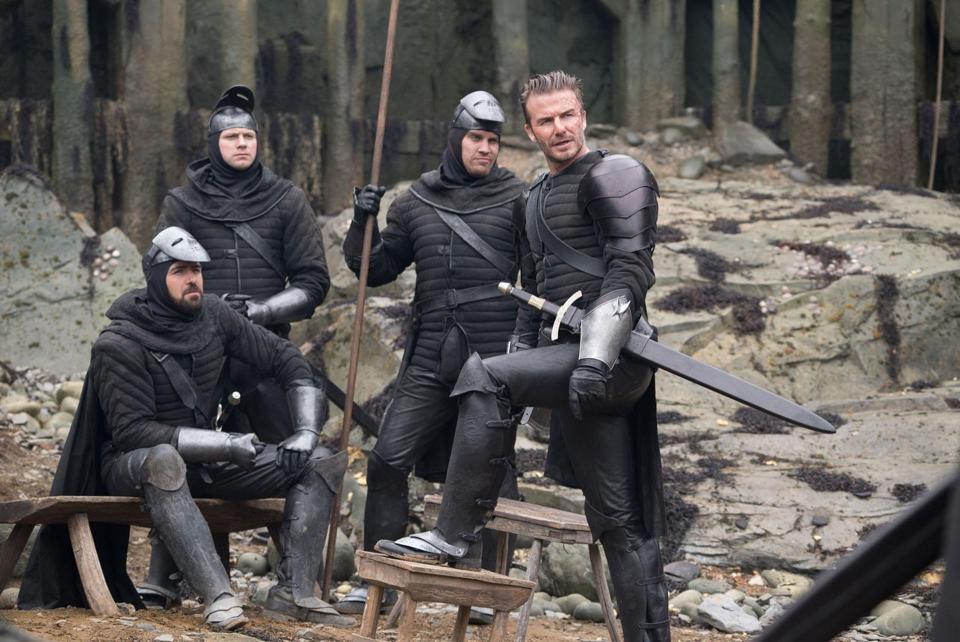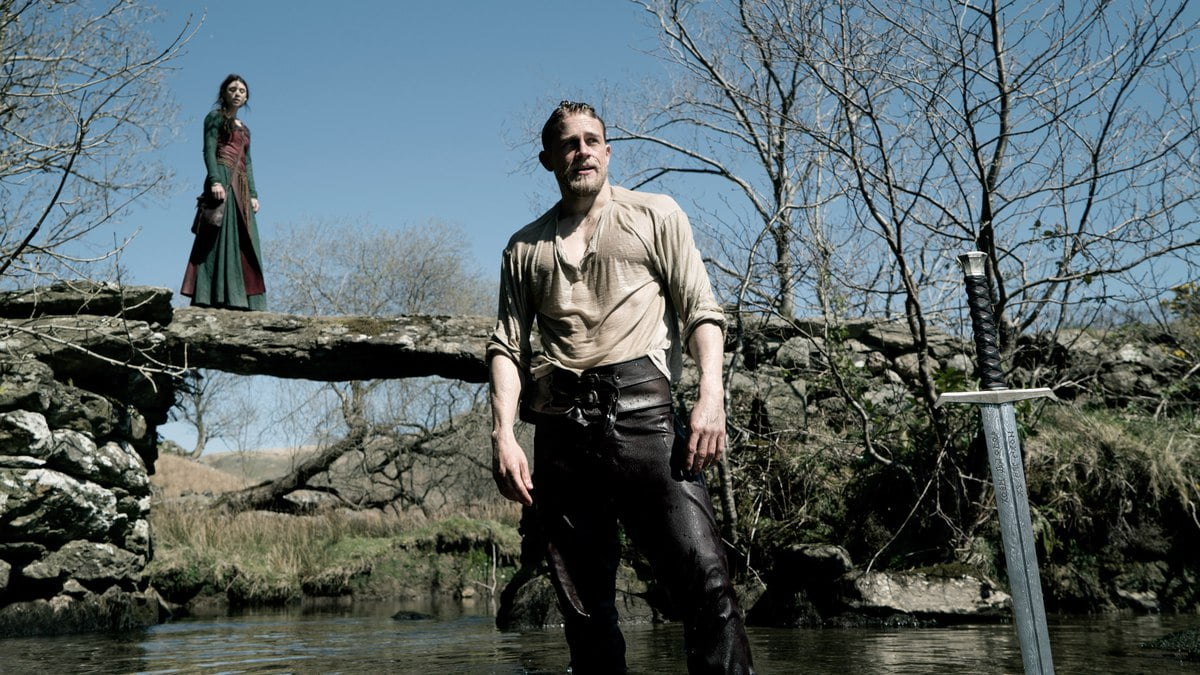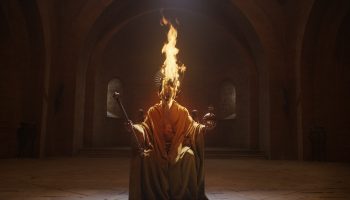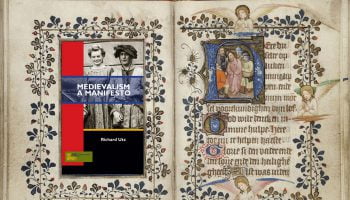 Review, King Arthur: Legend Of The Sword
Review, King Arthur: Legend Of The Sword
Director: Guy Ritchie
Runtime: 126 minutes
Rating: PG-13(US)/12A(UK)/M(Aus)
Cast: Charlie Hunnam, Astrid Bergès-Frisbey, Jude Law, Djimon Hounsou, Eric Bana, Aidan Gillen
Availability: Theaters everywhere May 12
Stories of King Arthur have been told many, many times. This story of King Arthur has not been told before.
That’s not to say that this movie doesn’t include components of Arthurian legend as it has solidified in popular imagination. But Legend of the Sword is something else.
Those looking for a retelling of medieval Arthurian literature won’t find it here. I’ve written about the historicity and development of the Arthurian legend elsewhere. Writer-director Guy Ritchie clearly isn’t concerned with that history, or any history for that matter. While Antoine Fuqua’s 2004 King Arthur attempted to portray some semblance of historicity (on the barest surface, at least), it’s clear from the first few scenes that this version is more akin to swords-and-sorcery high fantasy influenced by monuments like J. R. R. Tolkien’s The Lord of the Rings and Dungeons & Dragons.
This movie falls into the “superhero origin story” subgenre. It follows the rise of orphaned Arthur (Charlie Hunnam, channeling Sons of Anarchy’s Jax Teller) from street ruffian to king as he leads England in a revolution against his evil uncle, the tyrannical, brooding, King Vortigern (Jude Law). Along the way, we encounter Arthurian familiarities like Camelot (though crumbling, not glimmering). Arthur pulls Excalibur from the stone. He encounters the Lady of the Lake. And, at the very end (spoilers, by the way) the Round Table is under construction—mirroring the rest of the war-torn kingdom.
Audiences will recognize Ritchie’s characteristic style. King Arthur is full of slow-motion action, flash-backs and flash-forwards, close-ups, flashy camera angles, CGI, and background rock music. The rock music, by the way, falls somewhere between its more subtle inclusion in Robin Hood: Prince of Thieves and how it’s flaunted in A Knight’s Tale. And the characters are classic Ritchie too: at the beginning, we’re given a time-lapse montage depicting Arthur growing up, the mean streets he learns to navigate, and how he earns a reputation as a street-smart, aloof, and well connected prince of the alleyways. This is an Arthur not entirely out of place in Lock, Stock, and Two Smoking Barrels.
Ritchie is more interested in the pre-kingly Arthur than his legendary later self. There’s no romantic plot line in this tale; no Guinevere or Lancelot—a nice change of pace from other Arthurian films. There is no Mordred (who, strangely, is made a foe of the past in the first scene), and no tragic downfall. The movie is centered around Arthur as the head of a gang of revolutionaries creating a new society.
Ritchie brings his affinity for gangster stories to stylizing Arthur, his team, and elements of the plot. These features, along with several moments of deadpan lines and punchiness between Arthur and his friends make the film entertaining, at least in the moment.
Perhaps the most sustained theme is what it takes to rule well—a theme explored commonly, but rarely very thoughtfully, in many medieval films. For example, at one point Arthur and his unnamed magical lady-friend (more on her in a moment) have a conversation about the differences between a king and a man. This question is deeply embedded in medieval depictions of Arthur. True to the long history of Arthurian adaptations, Ritchie adapts it to appeal to his contemporary audience.

The core of this King Arthur adaptation is the grassroots resistance by a rag-tag team against an autocratic, tyrannical dictator. Ritchie draws on not-so-subtle imagery to trace a line from the fantasy-medieval world, through Nazism, and ending in present concerns about the relationships between leaders and the people. In one scene, Vortigern looks out at thousands of his subjects, separated by knights clad in all black with eerie face masks. Around him we see several images of eagles with outspread wrings, reminiscent of Parteiadler of the Nazi party. Moments later, Vortigern’s henchmen lead the people in hailing him with a Nazi salute.

Emphasis on autocratic tyranny and the battle against white supremacy is all the more pronounced given that Arthur’s resistance band, refreshingly, includes people of color. Among Arthur’s crew, we find black men like Bedivere (Djimon Hounsou) as one of the leaders, as well as childhood friend called Wet Stick (Kingsley Ben-Adir). Arthur even has a Chinese ally (it’s a fantasy, remember?) named George (Tom Wu). On the other hand, its racial politics aren’t all good; one character is a Chinese man nicknamed “Kung Fu George”—recycling the tired “martial arts master” stereotype rather than developing his character.

Where the film’s racial politics may be patchy, its gender politics are just plain bad. Like many medieval films, this movie doesn’t pass the exceedingly low bar of the Bechdel test. It would be difficult for the movie to pass, since the only woman in a leading role (Astrid Bergès-Frisbey) has no name; throughout the movie and in the credits, she’s called only “The Mage.” This might have been a conscious decision on the part of the filmmakers to lend her character an air of mystery. But by making the character nameless, she is inherently, sadly, relegated to a lesser position than the other two magicians, Mordred and Merlin—each of whom are only on screen briefly. The women who rescue Arthur as a child and raise him in a brothel (of course) are barely given lines; they’re later tortured by Vortigern. Women are objects in relation to the men around them. It’s telling that, at one point, Vortigern tells a court lady named Maggie (Anabelle Wallis) that she’s only a pawn to be used in his machinations. But the righteous Arthur seems not especially better.
There are a few clever aspects to the characters closest to Arthur. For anyone at least basically familiar with the Knights of the Round Table, it’s clear that the rag-tag men who help Arthur are destined to become his closest confidants. Two of these men are named Bedivere and Percival (Craig McGinlay). At the end, we learn Wet Stick’s true name, when he’s knighted (like the others) “Sir Tristan.” If medievalism fan-service is a thing, this is it.
It’s clear by the end of the movie that Ritchie’s vision is to jump-start a series of films based on the Arthurian legend. While the main plot wraps up, Arthur and his gang are given only a few brief moments to settle into the fixer-upper Camelot. There’s been rumor that Legend of the Sword is only the first of a projected six-part King Arthur series. Perhaps there’s more to come in a film cycle conceivably like Sir Thomas Malory’s Le Morte d’Arthur for the twenty-first century.
If not, King Arthur: Legend of the Sword at least provides a few hours of over-the-top entertainment around the world of Camelot. If you are looking for a nuanced, sophisticated new iteration of the Arthurian legends for the 21st century, this isn’t it. But if you go in expecting to see a few hours of relatively mindless entertainment, with a gangster-infused Arthur taking down a neo-Fascist Vortigern, you’ll find what you’re looking for.
The Public Medievalist does not pay to promote these articles, so we would love it if you shared this with your history-loving friends! Click to share with your friends on Facebook, or on Twitter.



